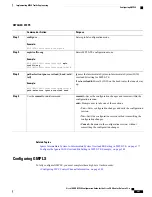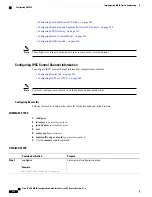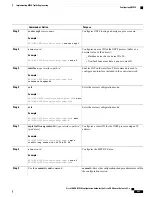
Purpose
Command or Action
•
Cancel
—
Remains in the configuration mode, without
committing the configuration changes.
Related Topics
Configuring Traffic Engineering Tunnel Bandwidth, on page 123
Prestandard DS-TE Mode, on page 172
Configure IETF DS-TE Tunnels: Example, on page 344
Configuring an IETF DS-TE Tunnel Using RDM
Perform this task to create an IETF mode DS-TE tunnel using RDM.
Before You Begin
The following prerequisites are required to create an IETF mode DS-TE tunnel using RDM:
•
You must have a router ID for the neighboring router.
•
Stable router ID is required at either end of the link to ensure that the link is successful. If you do not
assign a router ID to the routers, the system defaults to the global router ID. Default router IDs are subject
to change, which can result in an unstable link.
SUMMARY STEPS
1.
configure
2.
rsvp interface type interface-path-id
3.
bandwidth rdm
{
total-reservable-bw
|
bc0
|
global-pool
} {
sub-pool
|
bc1 reservable-bw
}
4.
exit
5.
exit
6.
mpls traffic-eng
7.
ds-te mode ietf
8.
exit
9.
interface tunnel-te tunnel-id
10.
signalled-bandwidth
{
bandwidth
[
class-type ct
] |
sub-pool bandwidth
}
11.
Use the
commit
or
end
command.
Cisco IOS XR MPLS Configuration Guide for the Cisco CRS Router, Release 5.1.x
233
Implementing MPLS Traffic Engineering
Configuring an IETF DS-TE Tunnel Using RDM






























